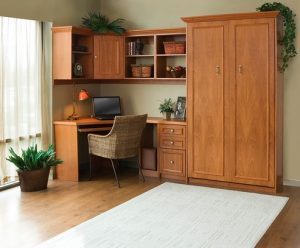Station An Office In The Bedroom That Doesn’t Make You Sleepy
When you’re awarded an opportunity to work from home, you need to plan how you’re going to work efficiently. Working from home is not as easy as it sounds. There will be distractions that affect your performance and productivity.
This is the reason why you should build a home office which can help you meet your job’s demands.
In my experience of working with Perth architects of Superdraft Australia, most homeowners want a separate room for their office. I’m sure that you do too. But what if you don’t have an extra room for your home office? Where are you going to station yours?
Sharing your bedroom and office would be nice when you have no other choice—the room is quiet, private, and free from distractions caused by the TV or another person. However, people who tried working in the bedroom felt drowsy at the sight of their bed, as if the mattress is alive and teasing them to get a nap.
Don’t get me wrong—it’s okay to take a break. It only becomes a problem when you have more idle moments than productive ones. Here’s how to get rid of the sleepy, lethargic feeling of working in the bedroom using design:
Make sure you don’t see the bed from your desk
Avoid the urge to sleep by turning your back on the bed. Keeping the bed off your sight steers any thought of a sweet slumber. It’s better to orient your work table so it faces a window or a wall.
Make your workspace ergonomic
Your body and mind will thank you if you employ proper ergonomics in your home office. It’s not just about getting the right desk and chair. Ergonomics deals with the design and arrangement of things so that people can use them easily and safely. Hence, get yourself a chair that supports your back, the table with the right height, and keep things on it organised and within your reach. If your workspace isn’t attuned to your needs, you’re most likely going to feel tired and sleepy at work, again.
Divide the room completely
There are numerous ways to squeeze your bedroom to get your ideal home office. You can use an area rug on either the bed or work area to create a distinction between the two areas. If the rug isn’t enough, try separating the two areas using screens, room dividers, or curtains.
Separating the two areas inside a room also keeps you from overworking. You will not see your computer when you’ve laid the curtains or dividers. You won’t get tempted to go online for another hour or two. Research says that people who sneak work before bedtime are less likely to get a good night’s sleep. This leads to drowsiness in the morning.

Hide work in the closet
Pop-up office spaces in a closet is a fabulous idea because you can simply shut the doors when you’re already done with work. Repurpose your bedroom cabinets and build a custom table in it. Make sure that you have a working and safe electric outlet nearby so you don’t need to relocate when you need to plug in your devices.
Or hide the bed
Ever heard of a Murphy bed? These beds are the ones that you can put up and tuck easily in the cabinet or in an alcove of your room. This makes your bedroom look and feels like a dedicated home office, inspiring you to do the daily grind.

Make sure there is ambient lighting
Proper lighting doesn’t strain your eyes, keeps you in a good mood, and boosts your morale. When working, it is ideal to have bright lighting to keep you alert. Open your windows and let natural light come in your space. If you have no windows, try using warm overhead and desk lamps. Make sure that your lighting doesn’t glare on your computer screen.
You can also install light dimmers in your bedroom. Use these dimmers after work, before your bedtime. Dimming the lights help relax your body, preparing you for sleep. The difference in lighting subconsciously attunes your mind and body to the room when it’s time for work or rest.
Cut the boredom
Don’t suffer from a dull workspace inside your bedroom. Boredom is the serial killer of productivity and creativity in the workplace. It burns you out!
As workplace designers, we encourage you to design your workplace based on your needs. Put plants near your office table, put up a creativity cork board, display photos and quotes which inspire you to work harder every day. If you’re sharing this office space with your partner, consider their needs too. Your office should work for the both of you.
Did you put your office in your bedroom? What else do you do to avoid feeling sleepy? Share your story below!
Author Bio
Charlene Ara Gonzales is a design writer from Superdraft Pty. Ltd., a company providing affordable architectural plans and drafting services across Australia. She gives advice on how people and businesses can benefit from proper design.
